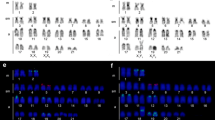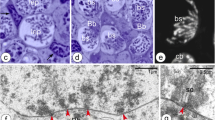Abstract
Observed differences in the sizes of lampbrush nucleolus organizers in Plethodon cinereus have been shown by in situ hybridization to reflect true molecular differences in the numbers of ribosomal cistrons located at these organizers. Likewise, from in situ hybridization experiments on lampbrush and spermatocyte chromosomes it has been shown that animals may be, and indeed usually are, heterozygous with respect to the numbers of ribosomal cistrons on each half of the nucleolus bivalent. Filter hybridizations carried out on 33 males from a New Jersey population and 20 males from a Connecticut population have shown a 7.5-fold range in the numbers of ribosomal cistrons per diploid cell in the New Jersey population, and a 2.5-fold range in the Connecticut population. In view of the general heterozygosity of nucleolus organizers in these animals, the actual range in nucleolus organizer sizes in the New Jersey population is estimated to be at least 15-fold.
Similar content being viewed by others
References
Birnstiel, M.L., Spiers, J., Purdom, I., Jones, K., Loening, U.E.: Properties and composition of the isolated ribosomal DNA satellite of Xenopus laevis. Nature (Lond.) 219, 454–463 (1968)
Brown, D.D., Weber, C.S.: Gene linkage by RNA-DNA hybridization. Unique DNA sequences homologous to 4S RNA, 5S RNA and ribosomal RNA. J. molec. Biol. 34, 661–680 (1968a)
Brown, D.D., Weber, C.S.: Gene linkage by RNA-DNA hybridization. II. Arrangement of redundant gene sequences for 28S and 18S ribosomal DNA. J. molec. Biol. 34, 681–697 (1968b)
Callan, H.G.: Chromosomes and nucleoli of the axolotl, Ambystoma mexicanum. J. Cell Sci. 1, 85–108 (1966)
Callan, H.G., Lloyd, L.: Lampbrush chromosomes of crested newts Triturus cristatus (Laurenti). Phil. Trans. B 243, 135–219 (1960)
Dawid, I.B., Brown, D.D., Reeder, R.H.: Composition and structure of chromosomal and amplified ribosomal DNAs of Xenopus laevis. J. molec. Biol. 51, 341–360 (1970)
Evans, H.J., Buckland, R.A., Pardue, M.L.: Location of the genes coding for 18S and 28S ribosomal RNA in the human genome. Chromosoma (Berl.) 48, 405–426 (1974)
Frankhauser, G., Humphrey, R.R.: The origin of spontaneous heteroploids in the progeny of diploid, triploid and tetraploid axolotl females. J. exp. Zool. 142, 379–417 (1959)
Ferguson-Smith, K., Handmaker, S.D.: The association of satellite chromosomes with specific chromosomal regions in cultured human somatic cells. Genetics 27, 143–156 (1963)
Funaki, K., Matsui, S., Sasaki, M.: Location of nucleolar organizers in animal and plant chromosomes by means of an improved N-banding technique. Chromosoma (Berl.) 49, 357–370 (1975)
Gall, J.G.: Lampbrush chromosomes from oocyte nuclei of the newt. J. Morph. 94, 283–351 (1954)
Gall, J.G., Pardue, M.L.: Nucleic acid hybridization in cytological preparations. In: Methods in enzymology, vol. XXI D (L. Grossman and K. Moldave, eds.). New York: Academic Press 1971
Gillespie, D., Spiegelman, S.: A quantitative assay for DNA-RNA hybrids with DNA immobilised on a membrane. J. molec. Biol. 12, 829–842 (1965)
Goodpasture, C., Bloom, S.E.: Visualization of nucleolar organizer regions in mammalian chromosomes using silver staining. Chromosoma (Berl.) 53, 37–50 (1975)
Hennen, S., Mizuno, S., Macgregor, H.C.: In situ hybridization of ribosomal DNA labelled with 125Iodine to metaphase and lampbrush chromosomes from newts. Chromosoma (Berl.) 50, 349–369 (1975)
Humphrey, R.R.: A chromosomal deletion in the Mexican axolotl (Siredon mexicanum) involving the nucleolar organizer and the gene for dark colour. Amer. Zoologist 1, 361 (Abstract) (1961)
Hutchinson, N., Pardue, M.L.: The mitotic chromosomes of Notophthalmus (=Triturus) viridescens: localization of C banding regions and DNA sequences complementary to 18S, 28S and 5S ribosomal RNA. Chromosoma (Berl.) 53, 51–69 (1975)
Kezer, J., Macgregor, H.C.: A fresh look at meiosis and centromeric heterochromatin in the red-backed salamander Plethodon cinereus cinereus (Green). Chromosoma (Berl.) 33, 146–166 (1971)
Kezer, J., Macgregor, H.C.: The nucleolar organizer of Plethodon cinereus cinereus (Green). II. The lampbrush nucleolar organizer. Chromosoma (Berl.) 42, 427–444 (1973)
Macgregor, H.C.: The role of lampbrush chromosomes in the formation of nucleoli in amphibian oocytes. Quart. J. micr. Sci. 106, 215–228 (1965)
Macgregor, H.C., Kezer, J.: The chromosomal localization of a heavy satellite DNA in the testis of Plethodon c. cinereus. Chromosoma (Berl.) 33, 167–182 (1971)
Macgregor, H.C., Mizuno, S.: In situ hybridization of “nick-translated” 3H-ribosomal DNA to chromosomes from salamanders. Chromosoma (Berl.) 54, 15–25 (1976)
Macgregor, H.C., Mizuno, S., Vlad, M.: Chromosomes and DNA sequences in salamanders. Chromosomes today 5, 331–339 (1976)
Macgregor, H.C., Walker, M.H.: The arrangement of chromosomes in nuclei of sperm from plethodontid salamanders. Chromosoma (Berl.) 40, 243–262 (1973)
Mancino, G., Nardi, I., Ragghianti, M.: Lampbrush chromosomes from semi albino crested newts, Triturus cristatus carnifex (Laurenti). Experientia (Basel) 28, 856–860 (1972)
McClintock, B.: The relation of a particular chromosomal element to the development of the nucleoli in Zea mays. Z. Zellforsch. 21, 294–328 (1934)
Miller, L., Brown, D.D.: Variation in the activity of nucleolar organizers and their ribosomal gene content. Chromosoma (Berl.) 28, 430–444 (1969)
Miller, L., Knowland, J.: Reduction of ribosomal RNA synthesis and ribosomal RNA genes in a mutant of Xenopus laevis which organizes only a partial nucleolus. II. The number of ribosomal RNA genes in animals of different nucleolar types. J. molec. Biol. 53, 329–338 (1970)
Sinclair, J.H., Carroll, C.R., Humphrey, R.R.: Variation in rDNA redundancy level and nucleolar organizer length of the Mexican axolotl. J. Cell Sci. 15, 239–257 (1974)
Spurr, A.R.: A low-viscosity expoxy-resin embedding medium for electron microscopy. J. Ultrastruct. Res. 26, 31–43 (1969)
Vlad, M., Macgregor, H.C.: Chromomere number and its genetic significance in lampbrush chromosomes. Chromosoma (Berl.) 50, 327–347 (1975)
Wensink, P.C., Brown, D.D.: Denaturation map of the ribosomal DNA of Xenopus laevis. J. molec. Biol. 60, 235–247 (1971)
Author information
Authors and Affiliations
Rights and permissions
About this article
Cite this article
Macgregor, H.C., Vlad, M. & Barnett, L. An investigation of some problems concerning nucleolus organizers in salamanders. Chromosoma 59, 283–299 (1977). https://doi.org/10.1007/BF00327970
Received:
Issue Date:
DOI: https://doi.org/10.1007/BF00327970




